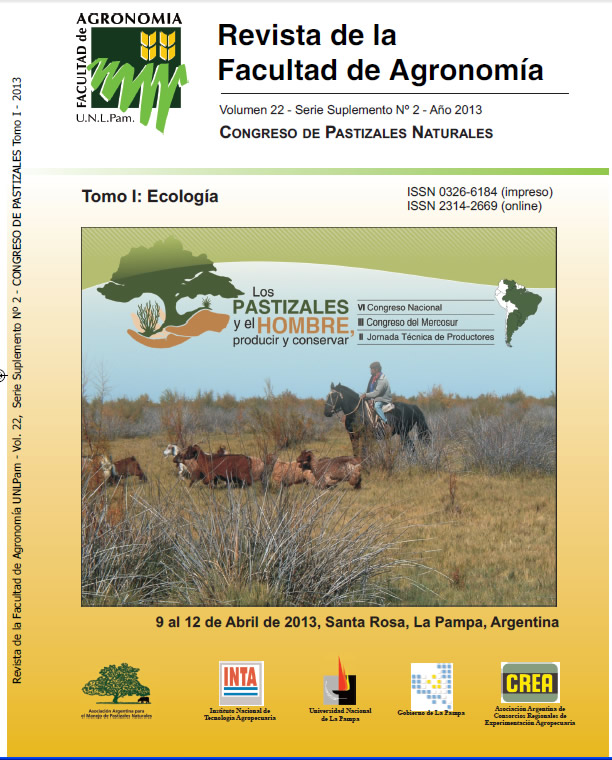Functional subdivision of landscapes in the flooding pampa
Keywords:
MODIS, landscapes, flooding pampa, TIMESATAbstract
The vegetation is one the most important indicators of changes in ecosystems. Often this information is useful for determining homogeneous landscapes, essential when planning a sustainable system. The aim of this study was to perform a subdivision of landscapes in the Flooding Pampa by analyzing functional aspects of vegetation obtained by means of remote sensing. We used a series of 11 year normalized difference vegetation index (NDVI) obtained from the sensor TERRA/MODIS. These data were fitted to a mathematical model in TIMESAT, which enabled the extraction of seasonal growing season variables in states “El Niño”, Neutral and “La Niña” (periods 2002-2003, 2004-2005 and 2008-2009, respectively). Subsequently, we performed a Principal Component Analysis which showed a 85.65% variance explained in the first three components, enabling the distinction of four different landscapes with phenological behaviors. The Tall-tussock grass range and agricultural landscape has the largest values of productivity and high growth seasons, the agricultural and range “flechillar” is characterized by low maximum values of NDVI and high levels of productivity. The landscapes Southern agricultural and ecotone agricultural and range have a similar behavior with short growing seasons, high maximum values of NDVI and low productivity, but in the Southern agricultural landscape the growing season is premature.Downloads
References
BOM (Australian Boureau Of Meteorology) 2002. Glossary. SOI. On line at: http://www.bom.gov.au/climate/glossary/soi.shtml
Cañibano M.A., M. Gandini & M. Sacido. 2004. Evaluación de la intensificación del uso de la tierra, en la cuenca del Arroyo del Azul, Buenos Aires, Argentina. Actas del XI Simposio Latinoamericano de percepción remota. Santiago, Chile.
Eklundh L. & P. Jönsson. 2009. Timesat 3.0 Software Manual, Lund University, Sweden.
Jönsson P. & L. Eklundh. 2002. Seasonality extraction and noise removal by function fitting to time-series of satellite sensor data, IEEE Transactions of Geoscience and Remote Sensing. 40(8) 1824-1832.
Jönsson P. & L. Eklundh. 2004. Timesat - a program for analyzing time-series of satellite sensor data, Computers & Geosciences. 30: 833-845.
LPDAAC (Land Processes Distributed Active Archive Center). 2006. U.S. Geological Survey. Sioux Falls, South Dakota, USA.
Lara B. & M. Gandini. 2011. Biogeografía de islas en fragmentos de pajonal del Paisaje Ariel (Azul, Buenos Aires, Argentina). Rev. Asoc. Argent. Ecol. Paisajes 2: 1-8.
Tricart J. 1973. Geomorfología de la Pampa Deprimida. Colección Científica XII, Instituto Nacional de Tecnología Agropecuaria, Buenos Aires. pp. 202.
Vervoorst F.B. 1967. Las comunidades vegetales de la Depresión del Salado (Provincia de Buenos Aires). La vegetación de la República Argentina. Serie Fitogeográfica 7, INTA. Buenos Aires. pp 262.
Downloads
Published
Issue
Section
License
La Editorial de la Universidad Nacional de La Pampa (EdUNLPam) exigirá a los/as autores/as la firma del siguiente documento:
La EdUNLPam lleva a cabo la publicación del artículo: (Título del Artículo) en SEMIÁRIDA Rev.Fac.Agron UNLPam ISSN 2362-4337 (impresa) ISSN 2408-4077 (en línea), del cual el/los abajo firmantes son autores de una o más partes. En el mismo acto, el/los autores entregan exclusivamente a la EdUNLPam todos sus derechos protegidos por las leyes de propiedad intelectual que rigen en la Argentina para reproducir, publicar, editar, fijar, comunicar y transmitir públicamente en cualquier formato o medio impreso o electrónico, inclusive internet, el artículo enviado a publicación e incluirlo en índices o bases de datos nacionales e internacionales. A cambio, la EdUNLPam entrega a los autores la autorización para la publicación o reimpresión con ines académicos y educativos en cualquier libro o medio de divulgación, con la sola obligación de citar el artículo original publicado en la EdUNLPam. Cada autor acuerda en que el material provisto a la EdUNLPam es un trabajo original, que no ha sido impreso o publicado en cualquier otro medio con anterioridad y que no vulnera derechos de terceros. El Primer autor tendrá la posibilidad de leer y corregir el artículo ya editado como “prueba de galera”, pero si el autor no devolviera esas correcciones de la prueba de galera dentro del tiempo especificado, el proceso de producción y publicación podrá proseguir sin la aprobación del autor. El/los autor/es no recibirán compensación monetaria de la EdUNLPam por el uso del material contenido en este artículo y asumen la responsabilidad de las opiniones vertidas en él.






.png)



22.png)



.jpg)




.jpg)
